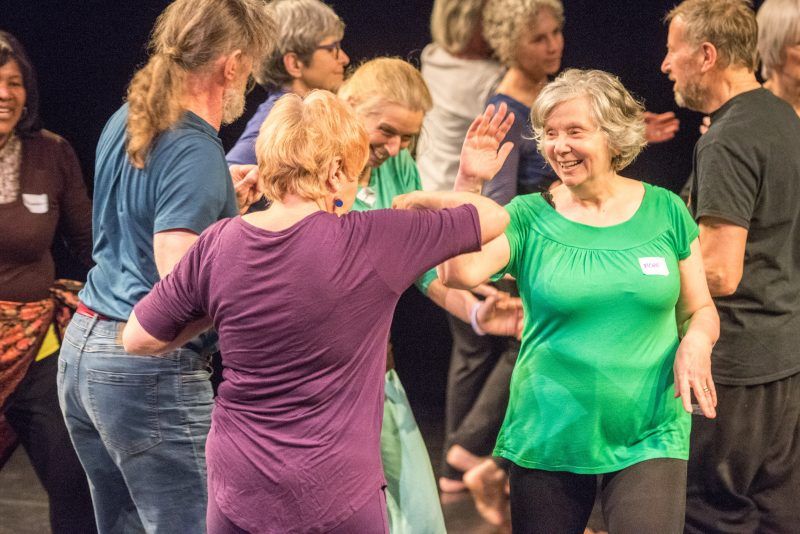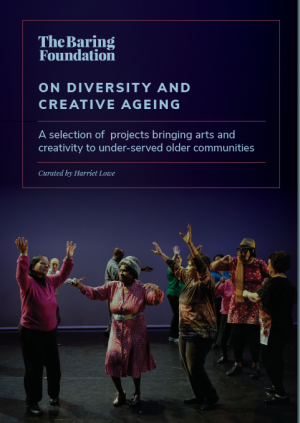Recently, I have been to a couple of events about ageism in the arts and in creative ageing. It’s a welcome and overdue discussion. Here are a few thoughts of my own.
My most tedious habit – of many – is an obsession with defining terms. So what is ageism? There doesn’t seem to be an official definition, but most would roughly say that it is negative attitudes towards someone based on prejudices about their age. And that could be regarding any age, but these thoughts will be about old age – whatever that means. Let’s be simplistic and say over 60 in this context, which coincidentally includes me.
There is more and more attention being given to this issue for society in general. Examples include campaigns by the Centre for Ageing Better in England and these two books by American authors; This Chair Rocks by Ashton Applewhite and Ageism Unmasked by Tracy Gendron. I don’t need convincing but I would certainly say that all these and many other examples provide a convincing case for the existence both of ageism at a structural societal level and how this is very often internalised to become our own fears about our future selves. A really important issue here is intersectionality. Ageism is compounded by other oppressions. Hags by Victoria White is a brilliant account of misogyny for instance compounding ageism. One of my favourite books is How to Age by Anne Karpf, not least as it introduced me to the much needed anti-ageist movement of the Gray Panthers, set up with a nod to the Black Panthers in the 1960s in the USA.
In my view ageism is the malign twin of ableism. There is a great correspondence between dismissing people with disabilities and seeing old age as a time of decreased ability. I am not very keen though on only representing older people mid sky dive or on a marathon. Not everyone will be doing those things and there are many health conditions that make us physically unwell or reduce cognitive capacities that are age related. The trap is to think of someone as no longer valid and no longer capable, in this context creatively capable, just because of physical or mental challenges.

Ageism in the professional arts is a huge topic and I really want to move quickly to creative ageing but in my view it is all too prevalent, though beginning to be challenged. Everyone can name great visual artists, actors, musicians, writers, architects and filmmakers in their seventies, eighties and nineties. Dance is always more problematic, but many initiatives, including the Elixir Festival founded by Sadler’s Wells, are challenging the idea that you are a spent force by 35. Even though the Turner Prize has got rid of an age limit, Granta had just issued their list of rising talent in British writing who are under 40, published every decade. I hope that age limit is binned before the next one. But this is all very much unfinished business especially when it comes to emerging artists.
So where does all this leave creative ageing? For the sake of this argument, I am going to use that phrase to meaning creativity by people over 60, especially people who are not earning a living through their creative practice.
When in 2010, the Baring Foundation started funding creative ageing, we deliberately said that we saw part of this approach to overtly challenge ageism. I think that is true in the most general sense that to be creative in later life is to show the possibilities of later life. But I also observe that very few of the hundreds of projects that we funded had ageism as the object or content of the work that is produced. When older people in the community or in care homes are given a choice about what the content of their creative output is, it rarely seems that that is about being old per se. That’s an interesting contrast with our current programme of engagement for people with mental health problems where is it much more likely that the art will be about how it feels to experience that mental health problem or the experience of mental health services.
What about the participatory artists that we are funding to engage with older people and transmit their creative skills to them. Are they also transmitting ageist attitudes? The great majority of participatory artists we have funded are not over 60 themselves, and indeed researchers are keen to emphasise ageism can, and frequently is, displayed in any case by older people. I can’t recall seeing ageist attitudes displayed by artists we have funded. They tend to see as central to their practice to be guided by what older people themselves as asking for but also to stretch this for instance by introducing new experiences and new artforms. So it isn’t by any means the tired cliché of only being interested in the Blitz and neglecting those that didn’t have that experience.
But this does all open up what I believe to be a valuable challenge to people working in creative ageing. How can they best be supported to question and improve practice, without this leading to unhelpful paralysis or condemnation? In much of the arts there is a discussion of how different communities are represented by artists and especially in the leadership of artists. I suspect rather few creative ageing arts organisations are professionally led by older artists, though I suspect that governance is becoming more attuned to this issue. My own observation is that the older people, especially in care homes that I see welcome engaging with artists from other generations. I shy away from the idea of policing who can engage with older people but diversity clearly needs to be a greater consideration in a field that is not at all diverse in terms of practitioners, something explored in our report and more recently in this recent report by CADA.
Creative ageing is growing and maturing. With that will surely come more examination of ageism both within creative ageing and as a subject of artistic creation. At the moment there is little in the way of guidance and support for artists to consider this issue in the context of their practice. Models from the Disabled Arts Movement might be helpful. This discussion will evolve and we mustn’t let self-examination become all-encompassing when there remains a need for lots of creative activity in the lives of older people. However, it is a necessary process and, perhaps more ambitiously, creative aging has a role in challenging ageism in society more broadly.
